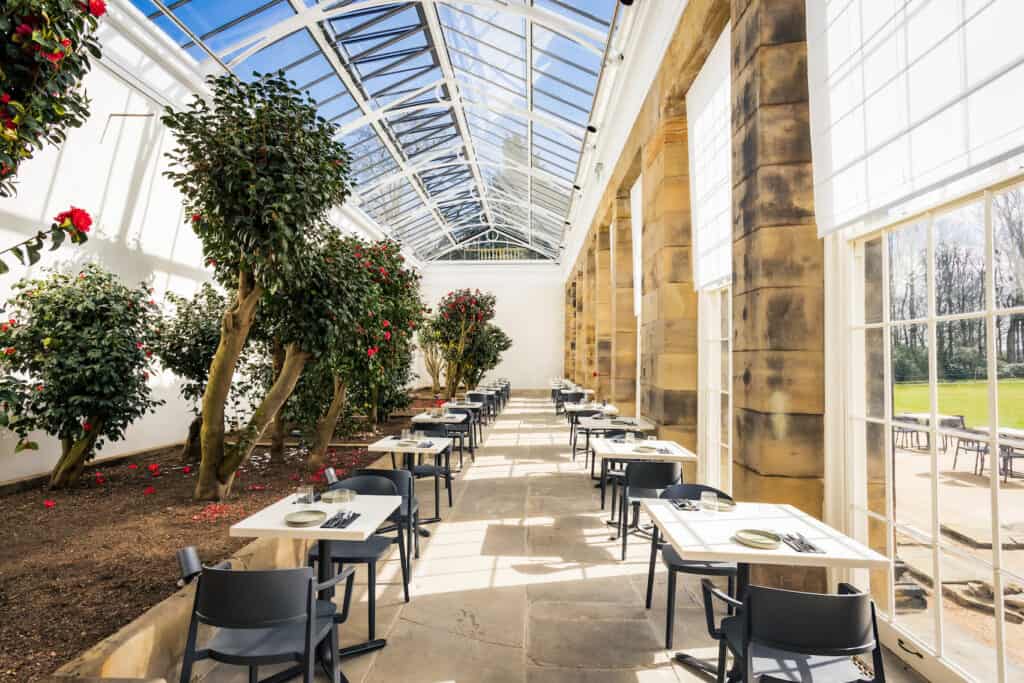
From an abandoned building listed on the Heritage At Risk Register to a magnificently restored tea house…Wentworth Woodhouse’s Grade II* listed Camellia House now enjoys a revitalised presence
Set in a secluded spot in the gardens of their prestigious stately home in Rotherham, the building served as a peaceful retreat for its aristocratic owners from 1738.
It was originally built as a tea house where the Marchioness of Rockingham Lady Mary Finch and her wealthy friends would sip the most fashionable drink of the day.
It later became home to some of Britain’s first camellias to arrive from China, each of which reputedly cost keen collector the 4th Earl Fitzwilliam the equivalent of a housemaid’s annual wage.
In the 20th century, it was still a beloved family haunt; Lt Col Burton ‘Bertie’ Gething chose the Camellia House as the idyllic setting to propose to Lady Donatia, third daughter of Billy and Maud Fitzwilliam.
But after the family departed in the 1980s, the Camellia House fell into decline and its blooms were forgotten.
When Wentworth Woodhouse Preservation Trust bought the mansion for £7 million in 2017, it was one of many buildings close to dereliction. Listed as Grade II*, it was on Historic England’s Heritage At Risk Register Only the once-pampered camellias had thrived; exposed to the elements, they had trunks the width of trees and were 30 feet tall.
In 2019, a discovery by Head Gardener Scott Jamieson gave the Trust even more reason to act swiftly. Many of the 19 camellias existing from a collection once numbering up to 30 were originals, likely dating from the early 1800s. They were deemed some of the oldest surviving in the Western world by the International Camellia Society.
Now, thanks to a year-long, £5 million restoration funded primarily with £4m from The National Lottery Heritage Fund and just over £614,000 from Historic England, the Camellia House has been saved and its precious plants protected.
Officially launched on Friday March 22, the Camellia House opens on April 2nd as a tea house, where people can take tea among camellias still thriving after 200 years.
Numerous heritage conservation challenges, not least the protection of the historic camellias, were overcome. Wherever possible, original materials and features were retained – including some of the country’s largest Georgian sash windows.
Energy-conserving methods introduced include carbon-neutral heating and a rainwater harvesting system, which irrigates the camellia plants and provides water for the WCs.
Sarah McLeod, the Preservation Trust’s CEO, commented: “Saving the Camellia House, removing it from the Heritage At Risk Register and giving it a new life is a huge achievement for us.
“It’s a significant step in our mission to build a financially sustainable long-term solution for Wentworth Woodhouse, so it can be enjoyed and used by local people for many years to come.
“We prioritised the Camellia House because it was in the most urgent need and it was vital that we protected our historic camellia collection. It now provides much-needed facilities for the gardens and means visitors can enjoy tea among the camellias, as the Marchioness did in the 1800s.”
Over 200 attended the official launch on March 22. After speeches and performances by South Asian dance group SuNrit Culture, the ribbon was cut by garden volunteer Harvey Hopkinson, a member of ArtWorks South Yorkshire, which supports adults with learning difficulties.


